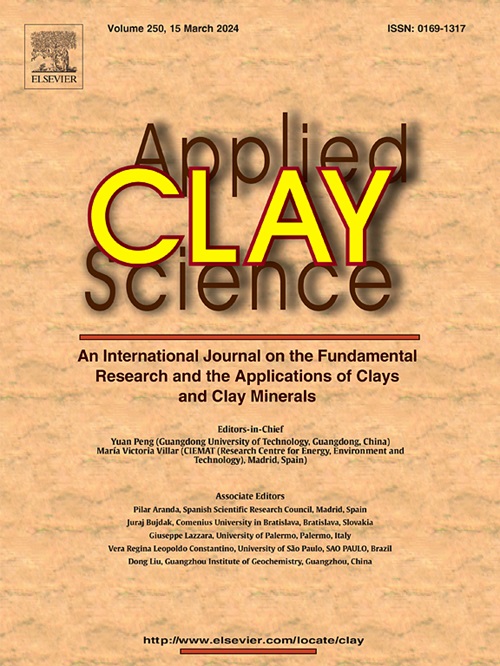层状双氢氧化物层间阴离子种类对复合材料阻燃性能的影响
IF 5.3
2区 地球科学
Q2 CHEMISTRY, PHYSICAL
引用次数: 0
摘要
层状双氢氧化物(LDHs)在聚合物阻燃中的应用越来越广泛,但目前的研究往往忽视了各种结构因素对聚合物阻燃效果的影响。这些因素对高性能阻燃剂的设计至关重要。为了研究阴离子种类与聚合物阻燃性之间的结构-功能关系,采用共沉淀法合成了分别嵌入苯甲酸(BA)、苯次磷酸(BP)和苯亚磺酸(BS)阴离子的BAL、BPL和BSL的MgAl LDHs。本研究系统地研究了它们的性能,包括阻燃性。尽管BAL、BPL和BSL结构相似,只是酸种类不同,但它们具有相似的层间距离,但在插层能力、结晶、热分解和表面疏水性方面存在差异。与纯EP相比,含LDHs的复合材料,尤其是BSL,在极限氧指数、垂直燃烧和锥形量热仪测试中表现明显更好。这种改进可归因于复合材料的碳化和分解途径的改变。三种LDHs对复合材料的拉伸强度和介电性能影响不大。研究结果表明,酸的种类对LDHs和复合材料的性能都有显著影响。此外,亚硫酸,或低密度聚合物中的硫元素,可能在聚合物阻燃中表现出优越的性能。这为LDH基阻燃剂的构效关系研究提供了有价值的见解,为设计新型、高效的LDH阻燃剂奠定了坚实的基础。本文章由计算机程序翻译,如有差异,请以英文原文为准。
The effect of anion species in the interlayer of layered double hydroxides on the flame retardancy of composites
Layered double hydroxides (LDHs) are increasingly being used in polymer flame retardancy, but current developments often overlook the effects of various structural factors on flame suppression effectiveness. These factors are crucial for the design of high-performance flame retardants. To investigate the structure–function relationship between anion species and polymer flame retardancy, Mg![]() Al LDHs of BAL, BPL and BSL, intercalated with anions of benzoic acid (BA), benzene hypophosphorous acid (BP) and benzene sulfinic acid (BS), respectively, were synthesised via co-precipitation. Their properties, including flame retardancy, were systemically investigated in this study. Despite their similar structures, with only differing acid species, BAL, BPL and BSL exhibited similar interlayer distances but varied in their intercalation capability, crystallisation, thermal decomposition and surface hydrophobicity. Compared to pure EP, the composites containing LDHs, particularly BSL, performed significantly better in limiting oxygen index, vertical burning and cone calorimeter tests. The improvement can be attributed to the carbonisation and altered decomposition pathways of the composites. All three LDHs seemed to have little impact on the tensile strength and dielectric properties of the composites. The results of this investigation indicate that the acid species can significantly affect both the properties of the LDHs and the composites. Furthermore, sulfinic acid, or the sulfur element in LDHs, may exhibit superior performance in polymer flame retardancy. This provides valuable insight into the structure–function relationship study of LDH-based flame retardants and lays a solid foundation for the design of novel, high-efficiency LDH flame retardants.
Al LDHs of BAL, BPL and BSL, intercalated with anions of benzoic acid (BA), benzene hypophosphorous acid (BP) and benzene sulfinic acid (BS), respectively, were synthesised via co-precipitation. Their properties, including flame retardancy, were systemically investigated in this study. Despite their similar structures, with only differing acid species, BAL, BPL and BSL exhibited similar interlayer distances but varied in their intercalation capability, crystallisation, thermal decomposition and surface hydrophobicity. Compared to pure EP, the composites containing LDHs, particularly BSL, performed significantly better in limiting oxygen index, vertical burning and cone calorimeter tests. The improvement can be attributed to the carbonisation and altered decomposition pathways of the composites. All three LDHs seemed to have little impact on the tensile strength and dielectric properties of the composites. The results of this investigation indicate that the acid species can significantly affect both the properties of the LDHs and the composites. Furthermore, sulfinic acid, or the sulfur element in LDHs, may exhibit superior performance in polymer flame retardancy. This provides valuable insight into the structure–function relationship study of LDH-based flame retardants and lays a solid foundation for the design of novel, high-efficiency LDH flame retardants.
求助全文
通过发布文献求助,成功后即可免费获取论文全文。
去求助
来源期刊

Applied Clay Science
地学-矿物学
CiteScore
10.30
自引率
10.70%
发文量
289
审稿时长
39 days
期刊介绍:
Applied Clay Science aims to be an international journal attracting high quality scientific papers on clays and clay minerals, including research papers, reviews, and technical notes. The journal covers typical subjects of Fundamental and Applied Clay Science such as:
• Synthesis and purification
• Structural, crystallographic and mineralogical properties of clays and clay minerals
• Thermal properties of clays and clay minerals
• Physico-chemical properties including i) surface and interface properties; ii) thermodynamic properties; iii) mechanical properties
• Interaction with water, with polar and apolar molecules
• Colloidal properties and rheology
• Adsorption, Intercalation, Ionic exchange
• Genesis and deposits of clay minerals
• Geology and geochemistry of clays
• Modification of clays and clay minerals properties by thermal and physical treatments
• Modification by chemical treatments with organic and inorganic molecules(organoclays, pillared clays)
• Modification by biological microorganisms. etc...
 求助内容:
求助内容: 应助结果提醒方式:
应助结果提醒方式:


